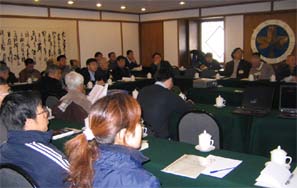

With the support of the Xiangshan Science Conferences, more than 40 Chinese particle physicists convened from Dec. 5 to 7 at the Xiangshan (Fragrant Hill) Hotel in the west suburb of Beijing, talking about China's involvement in the International Linear Collider (ILC), a global initiative in developing new electron-positron collider.
The meeting was co-chaired by KUANG Yuping from Tsinghua University, CHEN Jia'er from Peking University and CHEN Hesheng and CHEN Senyu from the CAS Institute of High Energy Physics (IHEP). It was attended by scholars from such research institutes and universities as IHEP, the CAS Institute of Theoretical Physics, Tshinghua University, Peking University, Shanghai Synchrotron Radiation Facility, Hefei National Synchrotron Radiation Laboratory, Orient Nonferrous Group in Ningxia, Shandong University, Zhejiang University, and Synchrotron Radiation Research Center in Taiwan.
A linear collider in TeV energy range will be the next-generation large-capacity laboratory installation for experiments in high-energy physics, according to experts. Together with the Large Hadron Collider (LHC) of the European Organization for Nuclear Research (CERN), which is due to switch in 2007, the device will be capable of exploring the fragmentation mechanism of electro-weak symmetry in nature, which helps deepen our understanding of the origin of masses and may lead to discovery of possibly existent new physics laws transcending the standard models.
LHC is capable of discovering new phenomena, say experts. However, sufficiently accurate measurement is needed to define these new laws, as it is beyond the capability of LHC. ILC can accomplish the task. For this reason, both can complement each other in research of particle physics. In August 2004, an international committee decided to adopt the superconducting technology in ILC, meaning that ILC will be the mainstream technology for global development of high-energy and accelerator physics. This is a historic chance, and China's high-energy community and industries must seize the opportunity.
To achieve the purpose, organizers of the meeting argue, adequate discussion should be held on how to organize an effective enough response. "We'll find ourselves in a plight over the next several decades if we fail to respond in good time."
The meeting focused its discussions on the following three topics: particle physics research, research of detectors, and advanced superconducting acceleration technologies, and scholars spoke about recent China's development in the field and made suggestions on future research.
After careful and in-depth deliberation, the participants agreed that ILC is of scientific importance, and could address many issues in modern physics. As its detectors and accelerators are S&T intensive, many of the know-how could be used to upgrade the R&D level of China's industry. Furthermore, the participation of the ILC could train a team of high-level researchers.
Although China has made encouraging progress in the field, further investments are needed so as to conduct pre-research of key know-how, and make substantial contributions to the major international collaboration.
ILC needs China's contribution, and China needs to join the partnership so as to share the research results, according to participants. Although the time and venue for the project are not decided yet, China should organize its researchers to make major contribution to the initiative.








